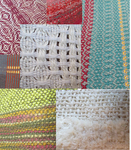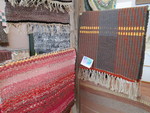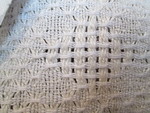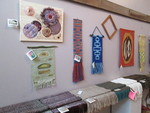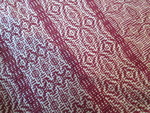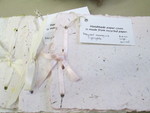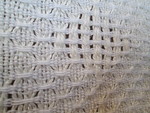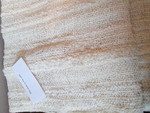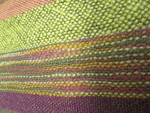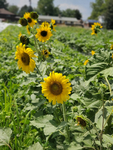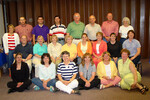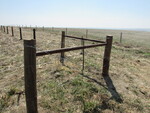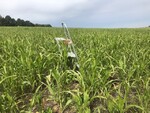by: Dianna Padgett
ST. FRANCIS—The artistic work of members of the Topeka Hand Weavers and Spinners Guild will be on display beginning Sept. 10 through Oct. 29 at the Quincy Gallery, 109 N. Quincy St.
The Topeka guild organized in 1956 to promote the art of hand spinning and weaving fiber. More recently the guild has expanded into all forms of fiber arts, including felting, dyeing, knitting and basketry. The guild has approximately 30 members from northeast and east central Kansas.
Underwriter for the Weavers and Spinner’s Exhibition is the St. Francis United Methodist Church Thrift Store.
The public is invited to view the fiber art and meet some of the artists at the show’s opening reception, beginning at 7 p.m., on Saturday, Sept. 10, at the gallery.
For more information, contact Kary Zweygardt 785-332-0308 my iPhone
Jeanette Wegle
Jeanette has been knitting for over 40 years. She has taught knitting privately, at Topeka guild meetings, at the Topeka Shawnee County Public Library, and as a 4-H leader. Her work is exhibited annually at Coffeyville's annual craft show and for over ten years her vintage clothing creations have been displayed and shown at the Vintage Van Shop and fashion shows in Lawrence. Her designs are inspired by paintings by Italian masters, fashion photos, and historic fashion plates.
Tricia Waggoner
Tricia lives in Topeka and enjoys many fiber arts: spinning, weaving, knitting, crochet, and felting. She learned to knit and crochet from her grandmother when she was seven. At thirteen Tricia learned to spin while volunteering at a living history museum in D.C. She currently works as an archaeologist at the Kansas Historical Society.
Regina Shaver
Regina has a fine arts degree in Weaving from KU. For over 17 years she taught weaving, rug weaving, Kumihimo and Nall binding for the city of Lawrence. Regina has taught fiber related classes for over 50 years and weaving for over 30 years on innumerable topics at guild meetings, fiber conferences, and schools in California, Arizona, New Mexico, New Jersey, Kansas, and Missouri.
Diane Hooper
Diane has been interested in fiber since childhood and spinning and weaving for more than 20 years. She attended a weekend spinning workshop and was hooked! She bought a wheel and continued to spin. She and her daughter took a weaving class together, and Diane has continued to weave since. She has a studio with two floor looms and various other pieces of fiber equipment. She is a member of the Topeka Handweavers and Spinners Guild of which she was recently elected president. Her focus is to encourage a new generation of weavers and spinners and therefore demonstrates at schools and historical events. She has taught several fiber classes for the guild and children.
Lois Herr
Hand and machine sewing, knitting, crochet, and tatting were part of Lois’s daily life from childhood. She watched her mother sew clothing for her family and her daughters' dolls. Lois learned to sew and embroider from her mother just as her mother had learned from Lois's grandmother. Gifts of a potholder loom as a child and a rigid heddle loom as a teenager sent Lois down the path of weaving. Lois has been weaving for over 35 years and spinning for 25. She sells handwoven clothing, baby wraps and other items. Lois has taught weaving to adults and children through guild meetings, conferences, workshops, private lessons, and 4-H.
Barbara Walters
Barbara has been fascinated by spinning wheels since first seeing one in a museum exhibit, and another in use in a program about Silver Dollar City. She finally learned to spin - and purchased a spinning wheel at an area weaving supply store, which came in handy while giving tours at the local historic park. After joining THWSG she purchased an inkle loom from a guild member who was downsizing, and then a used table loom at that same weaving store, and taught herself to weave with a lot of help from her friends! Barbara also has a 40", 4-harness floor loom, an extended family hand-me-down. She knits (learned in 4-H), crochets (rarely), tats, embroiders, quilts, and sews, but mostly reads!
Carol Benoit
Carol lives in Topeka, Kansas. While she has spent the majority of her life "knitting outside the lines", Carol has begun to explore other areas of the fiber arts. Several months ago she was introduced to silk fusion. The piece she submitted for this exhibit combines hand dyed silk hankies, fused with threads and paper and embellished with brads.
Linda Rogers
Linda is a new weaver! She lives in the country and started raising animals for fleece. When she got the fleece processed she realized that now she had to find something to do with it. She got a loom from a friend and with the help of a Topeka Handweavers and Spinners guild member completed the piece that was on the loom and then warped and wove her very first piece as part of a guild challenge. She has submitted that piece as part of this exhibit!
Marcia Wade
Marcia has been spinning and weaving and a member of the Topeka Handweavers and Spinners since 1986. She has devoted the third floor of her Victorian home to a Scandinavian designed floor loom. She is also a knitter. She enjoys making woven and knitted items and jewelry for her grandchildren.
Shirley Linn
Fiber artist Shirley Linn raises English Angora rabbits and spins and weaves their fiber. She has given demonstrations and taught mini-workshops in spinning, dyeing and felt making in the Topeka area and at Midwest Weaver's Conference. She has also participated in juried arts and crafts festivals.
Barbara Beyer
Barbara is a long time fiber enthusiast. She is an accomplished spinner and weaver. She also makes bobbin lace and knits. If she doesn't know how to do it, she will figure it out and put her own creative stamp on any fiber process she tackles!
Ronna has been active in the creative fiber arts for over 45 years. She enjoys exploring the use of very fine threads in bobbin lace to heavier fibers in knitting and weaving. Ronna taught classes for the Manhattan and Topeka guilds and at Midwest
Weavers Conference.
Additional Guilds Represented in the Sheep to Shawl exhibit:
Manhattan Area Weavers and Spinners
Keeping the traditions of weaving, spinning, and fiber arts alive in Manhattan, KS
maws.manhattan@yahoo.com
Kansas City Weavers Guild
The Kansas City Weavers Guild was organized in 1954 to promote hand weaving, spinning, and other fiber interests in KC area. We warmly welcome all fiber enthusiasts. The Kansas City Weavers Guild members are weavers, spinners, knitters, crocheters, dyers, basket makers, quilters, sewers, doll makers, tatters, felters, sheep and goat herders, jewelry makers, and lace makers. We paint, dye, embroider, embellish, batik, bead, marble, and cross stitch.
weaversguild@gmail.com
Flinthills Weavers Guild
Keeping the traditions of weaving, spinning, and fiber arts alive in the Emporia, KS area.
bmsay@osprey.net
Click on photos to view slide show
